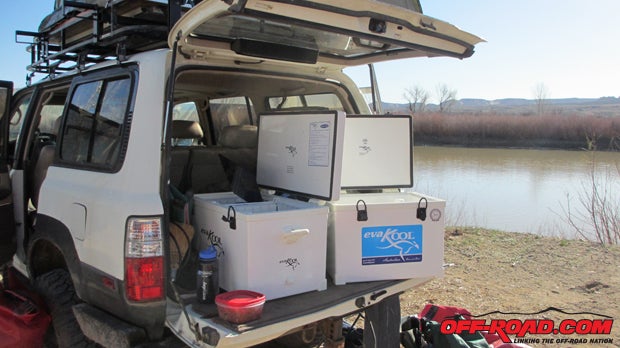
The headline in late July that caught my attention read: “Record breaking heat and drought sear Utah and the West.” Not a very rosy headline for most activities. But for torture testing a fridge/freezer, it was ideal. As I type this in July, the harsh heat continues to wither the Beehive state and surroundings. And it continues to offer an unsympathetic climate for keeping any sort of food or drink cool for more than a few minutes. All of which has made my job of trying products from EvaKool a breeze.
EvaKool originates from the idyllic Sunshine Coast in Queensland, Australia. Founded in 1994, and representing the largest manufacturer of fiberglass coolers and portable fridges in Australia, EvaKool established itself in the US in 2010. In 2012, as I was searching for a rugged, high-efficiency fridge/freezer, I soon came upon EvaKool as I found that all reviews of these devices soon point one toward the Aussies. Our mates Down Under have been realizing the value of 12-volt-powered coolers for well over a decade, and they’ve spawned several companies with offerings you’ve probably seen imported to North America. As a latecomer to the U.S. market, I was intrigued by what EvaKool had to offer.
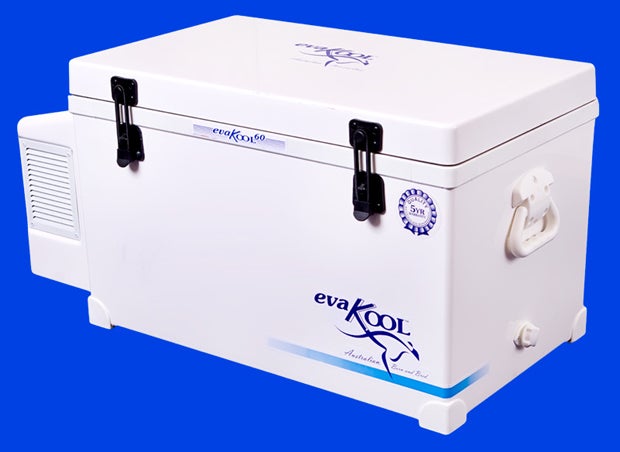
To learn more about the company and its products, I talked with U.S. General Manager David Levine. Based in Jupiter, Florida, David talked at length with me about the EvaKool line. After listening to my needs for multi-day desert overlanding trips, he recommended the Evakool RF Model, their premium, fiberglass-bodied, compressor-driven fridge/freezer lineup. The RFE60 (63.4 qt.) was settled on as the best fit for balancing volume with minimum energy consumption. As avid whitewater rafters, we were also in need of a traditional cooler to serve as the day-access drinks and lunch unit. David suggested that we give EvaKool’s mainstay fiberglass Icebox a trial. The E47 (49.5 qt.), the smallest of the lineup, was just right.
First Impressions
Two big cardboard boxes appeared after only three days following my conversation with David at EvaKool USA. The RFE60 is a beefy unit, but the foam-protected box was very well packed, with cardboard dividers to secure and shield the freezer. The E47 was just as well packed, though it weighs only 20 lbs.
I was anxious to find out how the RFE60 functioned. Too anxious, it turned out, to even look at the included manual. Such an attitude is good for gauging how a device works. In this case, the EvaKool was flawless. I coupled the power source and the green light came on, indicating proper operation. The whir from the fan confirmed the Danfoss compressor had come alive. I dialed the easily interpreted temperature control knob to its coldest setting, and placed a half glass of water into the freezer compartment, along with a freezer thermometer.
To gauge home power usage, I ran the AC power adapter through an Ensurpa PM001 power meter. Set to regular power, the EvaKool drew .55A (66w) for the first several minutes before lowering the rate to .5A (60w) for the next 10-20 minutes. The draw lowered and again and then stabilized at ~.38A (45w). Within an hour the water in the cup had frozen, and the thermometer was reading a steady 23F. “Wow! This things is fast!” I thought.
We began using the RFE60 and E47 in March of this year. To verify performance, I ordered a Mastercool Infrared Thermometer (#52224-A) and an Ensupra Electric Meter (#PM001) from Amazon. I also relied on a CDN Proaccurate Heavy Duty Refrigerator Freezer Thermometer to verify readings by the Mastercool. The units did duty on road trips, multi-day Utah raft trips, the three-day Kokopelli Trail Run at Cruise Moab, and numerous domestic uses, such as freezer overflow storage. A bit more unusually, we took the RFE60 to our mountain yurt where power was available only through a solar panel and deep-cycle battery system.
If you’re not familiar with portable 12v fridge/freezers, it’s not hard to find a range of discussions and even a handful of formal reviews. The variables to consider are fairly straight forward, and so you quickly realize that defining your personal priorities is critical for selecting a unit. In our family’s case, it was key that we optimized four criteria: energy efficiency, longevity, ease of cleanup/organization, and flexible cooling. Weight was not a major concern, but we did want a robust design with replaceable parts.
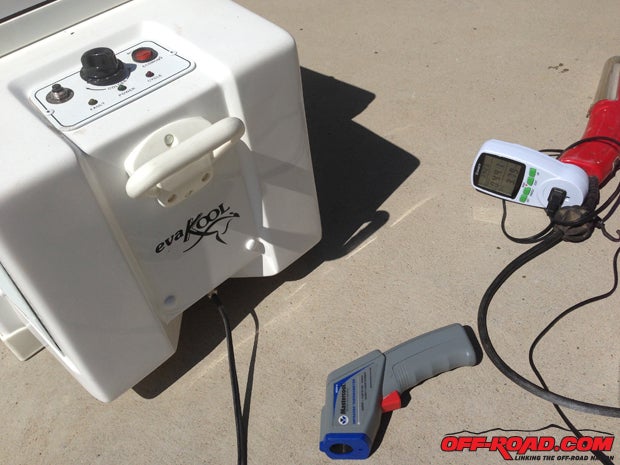
One of the first things you learn when shopping fridges, other than the fact that they’re imported, is that the quality of the compressor is critical to longevity and performance. Danfoss designs compressors are the undisputed leader in such units. They provide compressors for many of the top brands. Given these commonalities, the performance of fridge/freezers often points to other design and control features. The RFE60 relies upon the venerable Danfoss BD35. Unlike almost every competitor, however, the EvaKool places the compressor externally to the unit’s body. In effect, it’s designed like “reefer” trailers that haul America’s produce and perishable foods across interstates. The compressor is affixed to a highly insulated storage cooler, assuring that heat from motor is conveyed away through vents
Operating in Either Normal or Economy Modes
The settings are chosen by the user via the control panel. The compressor is manufacturer-rated to draw 1.4-1.8A per hour, or 1.0-1.2A per hour in its more efficient mode. At extremes, EvaKool reports the RFE60’s compressor draws as little as .7A/hr, and a maximum of 2.3A/hr. It’s not surprising that EvaKool captured 4wd Action’s “Most Power Efficient” award in its “No Bull Test” of leading fridge/freezers. Their finding verified what we learned: the RFE60 is the most energy efficient fridge/freezer available today.
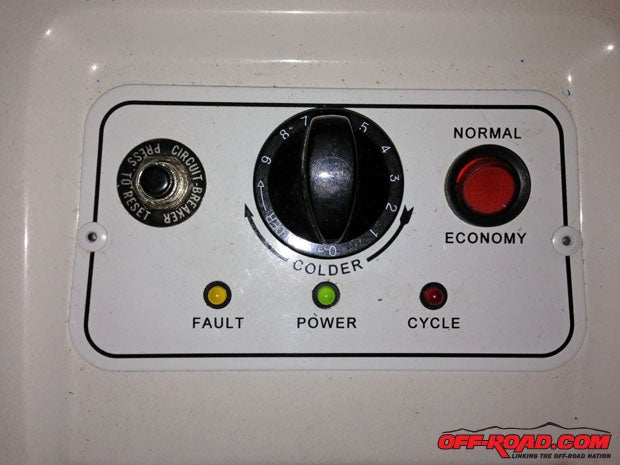
Since March, the RFE60 performed without flaw on our various trips and uses, and leading up to Utah’s incessant heat of June and July. Frozen foods and cold drinks were readily on hand as we explored slickrock canyons and climbed the northern Wasatch Mountains. But all of that usage has a disadvantage when it comes to testing; fridges are typically shielded from the sun in the back of your rig. To put the EvaKool to a tougher test I parked it in the middle of our concrete driveway in full summer sun. The test ran for five days, with the power mode changed between Economy and Normal to gauge changes, and temperatures taken at key daily highs and lows. Power was provided via the AC adapter. To measure cooling effects, three frozen water bottles were placed inside: two in the freezer, and the other in the fridge. A mechanical freezer thermometer was left in the freezer bottom to verify readings by the Mastercool thermometer. Numerous exterior temperatures were also taken to determine the surrounding heat with which the EvaKool was contending. The graph below tells the tale.
Click on the image below to expand the chart
As the figures reveal, the temperatures the RFE60 was subjected to were as severe as most off-road trips will experience. In all instances the big fridge was left in full sun on bare concrete. The peak pavement temperature of 147F underscores how harsh an unprotected fridge is treated. The take home is clear, however; the EvaKool can keep your ice hard in the most unforgiving temperatures. With the full divider in place between the freezer and fridge sections, the RFE60 kept the thermometer in the bottom of the freezer basket an average of 85 degrees cooler than the surrounding concrete. While we learned that the Economy setting can’t quite keep the fridge side of the RFE60 “cold” in shade-free 100 degree temps, it still manages to maintain very low temperatures on the freezer side. (NOTE: At such temperatures it is highly recommended that the fridge run in Normal not Economy mode. Additionally at extremely high temperatures the divider should be lifted by about an inch so as to allow the colder air from the freezer section to make its way into the fridge section.)
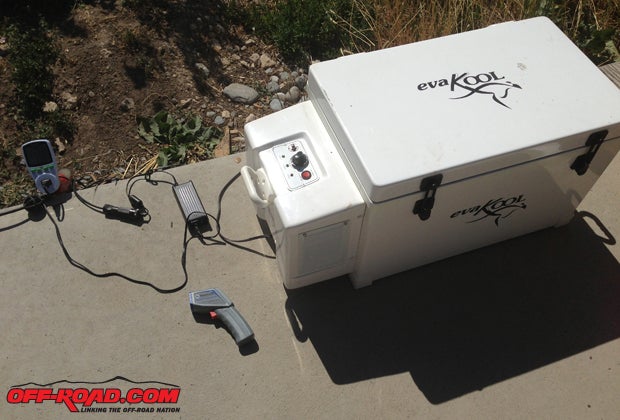
We also learned that the EvaKool’s energy consumption is directly proportional to the climate in which it is placed. Want to conserve energy? Find shade, a breezy location, and keep your fridge there. The RFE60 was frequently running astonishingly low amperage draws. But when high noon rolled around the scorching concrete meant it was pulling maximum power, at least when set to Normal. Not surprisingly, power consumption is also regulated by variations on the temperature setting, as well as the Economy vs. Normal controls.
When it comes to features, the RFE60 provides versatility and prospects for a long, long service life. Hinges, handles and latches are readily replaceable, and offered on the EvaKool Parts Store website. The pair of tough nylon handles makes two-person lifting easy (at 49 lb. empty, the loaded fridge can be a handful to lift). They are also plenty strong and well positioned to be used as tie-down points, a wise habit for any fridge when traveling in a vehicle. The removable coated metal bins provide organization for foods while retaining a gap off the bottom of the unit to ensure proper air circulation in the fridge. A drain cap allows draining of melt water or following washing out. The fiberglass construction means food smells can’t engrain into the surface like plastic surfaces. Feet on all four corners resist sliding on mounting surfaces, and increase cooling by limiting conductive heating when placed on hot surfaces like pavement.
When placed in a vehicle like our FZJ80, the ability to access and control a fridge is important for keeping the troops happy. Top-mounted controls make it easy to change settings. The lid opens in tight quarters to the side, making the typical longitudinal positioning in your rig an ideal setup. The offset width on the compressor, along with its side vents, mean that even in tight packing it’s easy to maintain the desired gap for airflow. When in serious off-road situations, the EvaKool continues to operate on the steepest of slopes and undulating terrain.
The RFE60 comes with a DC power source, along with an AC adapter. The latter uses a cigarette lighter-style receptacle into which the DC plug fits. The power cord connection to the compressor is situated out of sight and harm’s way under the compressor enclosure. The plug utilizes a threaded metal ring to secure the plug to the compressor connection, thus preventing accidental loosening. This is a great touch, and adds peace of mind from fears that off-road travel could accidentally cause power to be lost without it being realized. The 10-foot cigarette plug power cord coupled with the 110v AC power adapter (6 feet) gives flexibility in placing the fridge out of sight. The DC plug alone is easily long enough to reach from the rear of our Land Cruiser forward to the dash-mounted power plug.
E47 Icebox Cooler
The EvaKool line includes several cooler lines, in addition to the fridge/freezer offerings. To see how they stack up we also tested the smallest model in the Icebox line. The E47 is a fully fiberglass cooler that utilizes the same refrigeration-quality foam (1.7” thick) as the RFE60. Measuring 23” wide, 17.5” tall, and 17” high, the cooler holds just under 50 quarts and weighs 20 pounds.
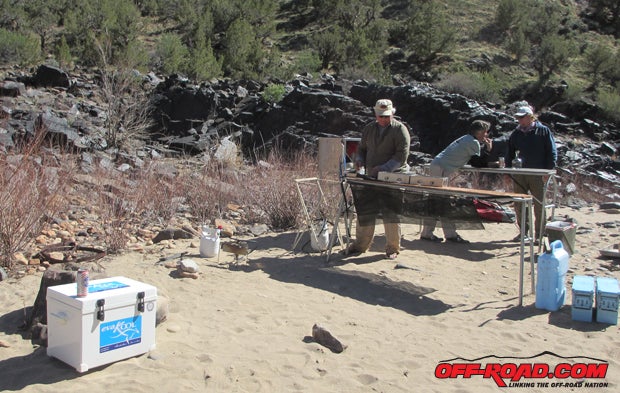
To test the cooler’s performance we took it on a variety of river and 4x4 trips. The most challenging for its insulating abilities was a four-day float in July on Utah’s Green River. Each day the clear skies elevated temperatures as high as 97F. We began the trip with a 2-pound block of ice, and a 3-pound bag of ice cubes. The ice was put in with chilled drinks the day before launching. Despite the desert temperatures, the ice block lasted well into the fourth day of the trip, making for a total of five days. The cubed ice was liquid after three days in the nearly full cooler. Water was drained off once each day to maximize ice longevity. The process was made simple using the convenient screw-off drain cap.
The E47 is no structural weakling. The stout fiberglass construction makes it plenty strong as a seat, step stool, or bench. Rubberized “feet” limit slipping by the otherwise smooth fiberglass finish. Beefy handles enable the cooler to be strapped down securely. How secure are they? We unintentionally tested that, too. The cooler, along with the rest of our 18-foot raft when wrong side up after piling into a house-sized rock on the Green. The boat was upside down, after being pulled from the rapids, for nearly half an hour. The cooler suffered no harm and took on no water, thanks to its foam lid seal and levering latches.
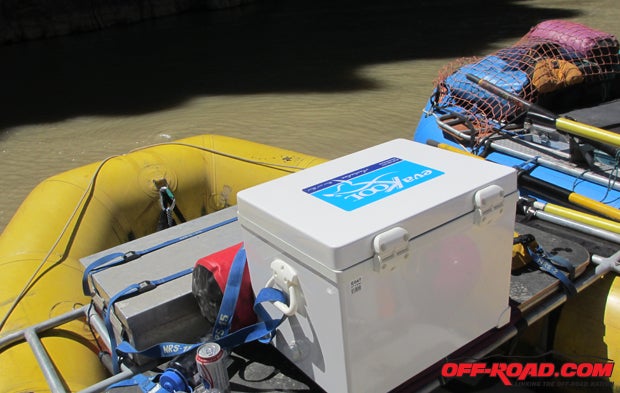
If you’re looking for a tough, lightweight and efficient cooler, the EvaKool Icebox line offers those features in models up to the monstrous 200-quart model. The only weakness we found so far, a weak pivot on the latches, was recently upgraded throughout the EvaKool line with a pivot that’s nearly twice as thick as the original. Covered under the five-year warranty, we’ve already received replacements for the old latch design. It looks like we’ll be keeping things cool with this cooler for years to come.
CONTACT
EvaKool-USA
http://www.evakool-usa.com/
info@evakool-usa.com



 Your Privacy Choices
Your Privacy Choices